当前位置:
X-MOL 学术
›
Biomater. Sci.
›
论文详情
Our official English website, www.x-mol.net, welcomes your
feedback! (Note: you will need to create a separate account there.)
Assembly of FN-silk with laminin-521 to integrate hPSCs into a three-dimensional culture for neural differentiation.
Biomaterials Science ( IF 5.8 ) Pub Date : 2020-03-26 , DOI: 10.1039/c9bm01624d Carolina Åstrand 1 , Veronique Chotteau , Anna Falk , My Hedhammar
Biomaterials Science ( IF 5.8 ) Pub Date : 2020-03-26 , DOI: 10.1039/c9bm01624d Carolina Åstrand 1 , Veronique Chotteau , Anna Falk , My Hedhammar
Affiliation

|
Three-dimensional (3D) neural tissue cultures recapitulate the basic concepts during development and disease better than what can be obtained using conventional two-dimensional cultures. Here, we use a recombinant spider silk protein functionalized with a cell binding motif from fibronectin (FN-silk) in combination with a human recombinant laminin 521 (LN-521) to create a fully defined stem cell niche in 3D. A novel method to assemble silk blended with LN-521 together with human pluripotent stem cells (hPSC) is used to create centimeter-sized foams, which upon cultivation develop into 3D cell constructs supported by a microfibrillar network. After initial cell expansion, neural differentiation was induced to form a homogenous layer of continuous neuroectodermal tissue that allows further differentiation into neuronal subtypes. The silk-supported 3D cell constructs could then be detached from the bottom of the well and cultured as floating entities, where cells appeared in distinctive radial organization resembling early neural tube. This shows that the neural progenitors retain their cellular self-organization ability in the FN-silk/LN-521-supported 3D culture. Calcium imaging demonstrated spontaneous activity, which is important for the formation of neuronal networks. Together, the results show that hPSCs integrated into FN-silk/LN-521 foam develop into neural progenitors and that these stay viable during long-term differentiations. FN-silk/LN-521 also supports morphogenesis mimicking the human brain development and can serve as base for engineering of hPSC-derived neural tissue.
中文翻译:

FN丝蛋白与层粘连蛋白521的组装,可将hPSC整合到三维培养物中进行神经分化。
三维(3D)神经组织培养比传统的二维培养能更好地概括发育和疾病期间的基本概念。在这里,我们结合人类重组层粘连蛋白521(LN-521)使用来自纤连蛋白(FN-silk)的细胞结合基序功能化的重组蜘蛛丝蛋白,以3D方式创建完全定义的干细胞生态位。一种将与LN-521和人类多能干细胞(hPSC)混合在一起的真丝组装的新方法用于创建厘米大小的泡沫,该泡沫在培养后发展成由微纤维网络支撑的3D细胞构建体。初始细胞扩增后,诱导神经分化形成连续神经外胚层组织的均质层,从而允许进一步分化为神经元亚型。然后可以将丝支撑的3D细胞构建体从孔的底部分离,并作为漂浮实体进行培养,其中的细胞以独特的径向组织形式出现,类似于早期的神经管。这表明神经祖细胞在FN-silk / LN-521支持的3D培养物中保留了其细胞自组织能力。钙成像显示自发活动,这对于神经网络的形成很重要。总之,结果表明,整合到FN-silk / LN-521泡沫中的hPSCs发育成神经祖细胞,并且在长期分化过程中仍保持活力。FN-silk / LN-521还支持模仿人类大脑发育的形态发生,并可作为工程化hPSC衍生神经组织的基础。
更新日期:2020-03-18
中文翻译:

FN丝蛋白与层粘连蛋白521的组装,可将hPSC整合到三维培养物中进行神经分化。
三维(3D)神经组织培养比传统的二维培养能更好地概括发育和疾病期间的基本概念。在这里,我们结合人类重组层粘连蛋白521(LN-521)使用来自纤连蛋白(FN-silk)的细胞结合基序功能化的重组蜘蛛丝蛋白,以3D方式创建完全定义的干细胞生态位。一种将与LN-521和人类多能干细胞(hPSC)混合在一起的真丝组装的新方法用于创建厘米大小的泡沫,该泡沫在培养后发展成由微纤维网络支撑的3D细胞构建体。初始细胞扩增后,诱导神经分化形成连续神经外胚层组织的均质层,从而允许进一步分化为神经元亚型。然后可以将丝支撑的3D细胞构建体从孔的底部分离,并作为漂浮实体进行培养,其中的细胞以独特的径向组织形式出现,类似于早期的神经管。这表明神经祖细胞在FN-silk / LN-521支持的3D培养物中保留了其细胞自组织能力。钙成像显示自发活动,这对于神经网络的形成很重要。总之,结果表明,整合到FN-silk / LN-521泡沫中的hPSCs发育成神经祖细胞,并且在长期分化过程中仍保持活力。FN-silk / LN-521还支持模仿人类大脑发育的形态发生,并可作为工程化hPSC衍生神经组织的基础。











































 京公网安备 11010802027423号
京公网安备 11010802027423号